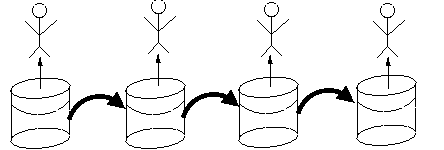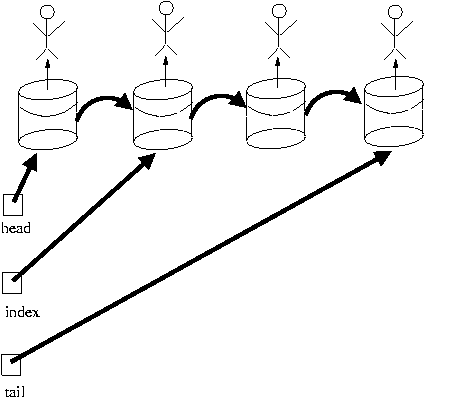Today we talked about linked lists. As you know, there is a competency
exam at the end of the semester, which is worth 30% of your final grade.
This exam has three questions, and two of them are on linked lists.
So, not only is this material about something fundamental to the
discipline, it is critical to your grade. It will form much of
the base of the material for the next exam -- and account for up to
two letters of your final grade through the end-of-semester exam
(2/3*30% = 20% of your final grade).
So let's back up a little bit. What is a list? A list is a collection of
things, possibly ordered, depending on your usage. For instance, a shopping
list can be in any order, but if you want to make a scheduled list of
things to do, you will probably want them to be in some sort of
chronological order. Now, what is a link? A connection between two things.
So what is a linked list? A collection of things that are connected one by
one. Let's think of it this way: Imagine you have a bunch of buckets.
What's missing in this picture? The links!

So we not only need something to hold an object, but a reference to the
next bucket. We call this combination of a bucket and it's link a Node.

Each Node contains two things: A reference to the Object the "bucket" is
containing and a reference to the next Node in the list. Here's a loose
skeleton of a Node:
private class Node {
private Object data;
private Node next;
public Node(Object o, Node next) { };
public Node getNext() {};
public Object getData() { };
public void setNext(Node Next) { };
}
You'll notice that the class is private. Why is this? Consider the Java API
for a Linked List. Do you ever see anything to do with any sort of Node?
No, so that's exactly why it's private. No one outside of the LinkedList,
itself, needs to know about what goes on at the Node level, so the class
is private.
We've talked about the Nodes that make up a linked list, but what do we
actually need in the list? Well, we definitely need the first Node, right?
Once you have the first Node, you can access the rest of the list. But
now what? You can look at the first Object, but how useful is that? You
need to be able to look at all the other Objects as well, without losing
your handle on the first Node.
Imagine you are holding onto a box of index cards with one hand. You can
access the cards, since they're all in your possession, but if you try to
reach into the box with the same hand you're holding the box with, you'll
drop all of them. So what you need is another hand to sift through the
stack, right? So we need a reference to a helper node that we'll use to
traverse your Linked List. We'll call this one an index.
Another thing we want to know in the list is where the tail is, so we can
add to the end of the list just as efficiently as we can add to the
beginning, instead of having to send the index all the way down to the end.

So here's a very basic (and meager) structure of a LinkedList class:
private class LinkedList {
private class Node{
//see above
}
private Node head;
private Node tail;
private Node index;
public LinkedList( ) { };
public void addHead(Object o) { };
public void addTail(Object o) { };
public boolean find(Object o) { };
public Object remove(Object o) { };
}


